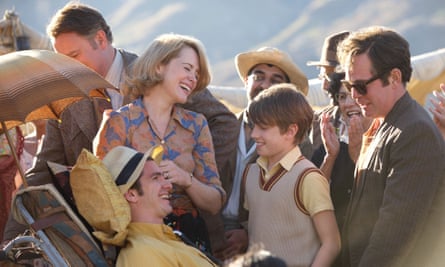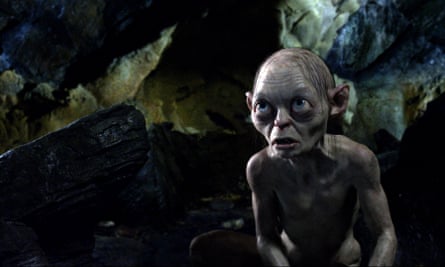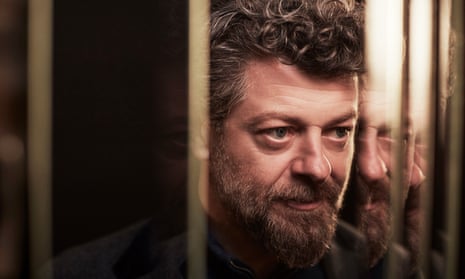Breathe is not technically Andy Serkis’s first film as a director. He had already shot his adaptation of The Jungle Book using the performance-capture technology for which the man inside Gollum has become known. But while that was in post-production, Serkis found time to direct Breathe. There is a bit of CGI – Tom Hollander plays twins – but, otherwise, it’s an interestingly old-fashioned film from a man who likes to talk about digital characters and next-generation storytelling.
It was the script that did it, he says. “I really did cry my eyes out, and that never happens to me.” It was one of the films on the slate of the Imaginarium, the performance-capture studio and production company Serkis had set up with the film producer Jonathan Cavendish. Serkis was lined up to do the more whizzy performance-capture films such as adaptations of Animal Farm and The Jungle Book – the latter an entirely separate reworking from the Disney adaptation released in 2016 (both films went into production at roughly the same time) – but he asked Cavendish if he could direct Breathe. Could anyone turn down Serkis? As soon as I meet him, I’m struck by how warm and bighearted he seems – blue eyes shining, wild badgery hair and an unassuming manner.
Breathe was Cavendish’s story – or rather that of his parents. After they married, Diana and Robin Cavendish found themselves living a gilded upper-middle-class life in colonial Kenya, where Robin was a tea broker, in the late 50s. A “pampered nitwit” is what Diana (played by Claire Foy) later calls herself when their privileged world implodes after Robin (Andrew Garfield) contracts polio. Diana was pregnant with Jonathan by then, and Robin, paralysed from the neck down, is brought back to live in a hospital in Oxfordshire where he – and other people with polio – are kept alive with respirators.

Robin can’t accept that his life has shrunk to the edges of his hospital bed. Serkis loved, he says, the “sense of these people pioneering a completely new approach”. “When Diana says to Robin, ‘How can I make life better for you?’ and he’s in hospital during his depression, he says, ‘Get me out of here.’ That moment for me was akin to, at that time [somebody saying], put me on the moon or help me climb Mount Everest.” Diana learned how to work the respirator (and use a manual one in case of power cuts) so he could be at home. They were told he wouldn’t live for more than two weeks. “It was extraordinary what they were trying to do. The fact that they were willing to take that risk so that he could embrace life was such a powerful idea.”
The other thing he loved was the Cavendish’s rather old-fashioned English unsentimentality. “Bit of a bugger,” is how Robin describes his condition. “It was really buttoned down,” says Serkis. “I think that’s what makes you feel more for it. It was their understated, stoic, humorous approach to choosing to live two minutes away from death [if the respirator failed with no hospital backup], but with such vibrancy.”
Throughout his life – he lived, against all expectations, into his 60s – Robin Cavendish became a pioneer in disabled living. His friend, the Oxford scientist and inventor Prof Teddy Hall, built a wheelchair with a battery-operated respirator, which meant he and Diana could resume, to some extent, their adventurous lives. Robin also became a campaigner and speaker, changing attitudes about people with disabilities.

It is an area Serkis had an interest in long before he played someone else who had polio, Ian Dury in Sex & Drugs & Rock & Roll. His mother taught children with special needs, so he grew up seeing the issues surrounding disability; his sister was diagnosed with multiple sclerosis 20 years ago and uses a wheelchair. “I see how difficult it is for her to get around in 2017, and just think back to attitudes towards disability [in the 60s], which we go into in the film,” he says.
It’s a little disappointing, though, that there are no disabled actors in the film. Serkis says he did approach theatre companies that work with disabled artists, but, for various reasons, it didn’t happen. Did he ever consider casting a disabled actor for the lead? “We couldn’t ever do it for the lead role because there is a huge part of Robin’s life where he is able-bodied,” he says. But surely he, perhaps more than anybody, could have found a way around that – if a man can play a giant gorilla, can’t a wheelchair-using actor be depicted as able-bodied? “Possibly,” he says. “If it was one shot, maybe it would have been achievable. But it would not have been practical [in this film]. We were all hugely aware of it, but we didn’t consider it for Robin because of the sheer time he had to be able-bodied.”
Serkis has been working towards directing for many years. He made short films early in his career and did some performance-capture directing for video games before starting his production company with a view to making films. (Peter Jackson, the director of Lord of the Rings, asked him to direct the second unit on the three Hobbit films.) He will still act, he says, “but I also love seeing a story through, being responsible for how it looks aesthetically … how you choose point of view and how you lead an audience through a story. That really fascinates me.”
He didn’t even originally want to be an actor. He wanted to be an artist, which horrified his parents – his mother was a teacher and his Iraqi-Armenian father was a doctor – and “they were doubly horrified when I wanted to be an actor”, he says with a laugh.

Serkis’s father lived and worked in Baghdad for most of his childhood (Serkis and his four siblings were brought up in west London by their mother) where he founded a hospital with three other doctors. During school holidays the children would go to visit him. Serkis was always aware of his heritage. “I definitely don’t feel entirely British,” he says. “I had lots of cousins who I don’t see so much of now but grew up with. So I’ve always felt not entirely of one place.”
At one point, Serkis’s father, thought to be a British spy, was arrested and imprisoned for several weeks. “A lot of his friends had vanished and I don’t think [my mother] expected him to reappear. But he did, and then his hospital was taken away by the Ba’ath party – and that was the beginning of him getting out.”
By then, Serkis had been at Lancaster University, where he was studying visual arts, but had also discovered acting – by the end of his first year, he had been offered a lead role in the play Gotcha by Barrie Keeffe. He loved, he says, “the process of allowing your imagination to completely transform you into another human being. Then, actually, the first proper professional director I worked with, Jonathan Petherbridge, really made me understand why I wanted to become an actor, which was that acting is a force for change.” He taught Serkis, a former member of the Socialist Workers party, “that art does change society, and I still believe that. That’s what I think keeps me driving forward.”
Does he find it strange, and a bit random, that he has become a performance-capture expert? He laughs. “I certainly didn’t intend to. When I started doing Lord of the Rings, I liked the gamble. Originally, I heard it was going to be like doing a voice for a digital character, and I wasn’t that interested, but then I met Peter Jackson and he said: ‘We want an actor to play the role, be on set and make decisions for that character.’” After the trilogy, Serkis thought he would return to a life of conventional acting, if in unconventional roles (he played Ian Brady in the Channel 4 film Longford, eccentric record producer Martin Hannett in 24 Hour Party People and the menacing Rigaud in the BBC’s Little Dorrit).
Then he was offered the role of King Kong in Jackson’s 2005 film. “That was the epiphany because it was like: you can now play anything. Then, as the technology evolved and facial capture came into play, and [it became] total performance capture, not just motion, I realised how important it is as an actor’s tool in the 21st century.”
The perception of the work – that it is not just doing a voice, but acting – has, he says, “radically changed” in the past few years. “You can see that by the number of great actors who want to take on performance-capture roles: Mark Rylance playing the BFG, and we’ve got a great cast for Jungle Book – Cate Blanchett, Benedict Cumberbatch, Christian Bale.” When will an actor using performance capture first win an Oscar for acting? “Who knows? I think there is a growing perception within the awarding bodies that it is acting, that it doesn’t matter whether you’re putting on a costume and makeup or having your performance manifested on screen as a sort of digital makeup.”
As for whether it will only work on an emotional level with a human “inside” the character, Serkis laughs and says he doesn’t know. “That’s such a huge debate about any form of interaction with AI. Can we all be replaced?” What will he do when he’s out of a job? “Go back to climbing mountains,” he says instantly, smiling. “It’s the nearest thing I have to any sort of spirituality – you feel very connected to the world.” There was one moment, during a solo climb of the Matterhorn, when it went “a bit wrong, and you’re hanging off your ice axe waiting for the dawn to come, to see where you’ve gone off-route”.
Mountaineering, he says, is “like being totally in the moment because the situation changes so drastically from minute to minute”. It’s a kind of throwaway remark that comes as our time is winding down and our tea is cold, but it suddenly seems to explain why Breathe is Serkis’s perfect debut film after all. What had appealed about Robin and Diana’s story, he had said earlier, was really about choosing to live in the moment.
Breathe is released in the UK on 27 October

Comments (…)
Sign in or create your Guardian account to join the discussion